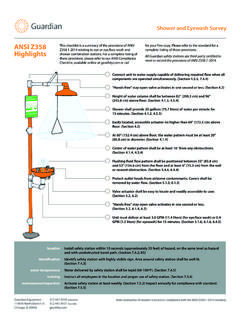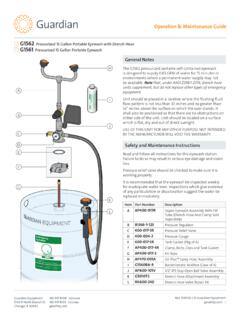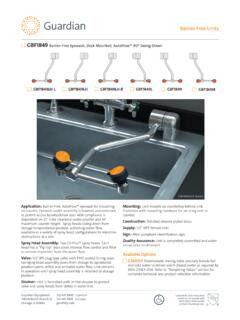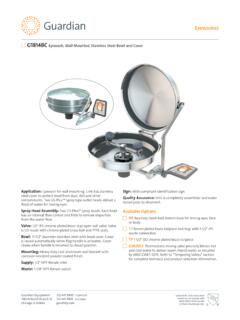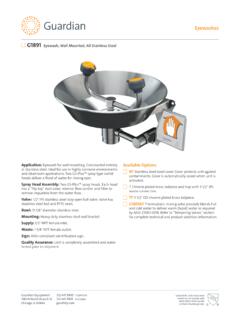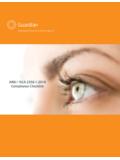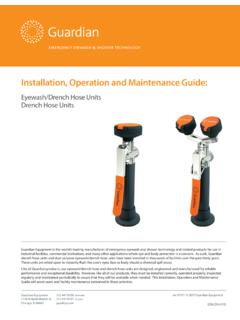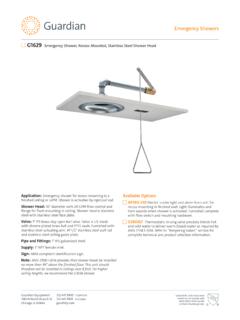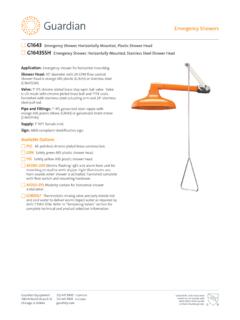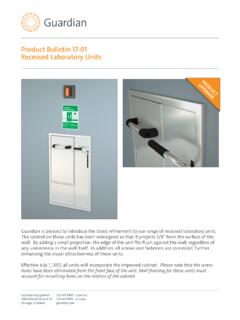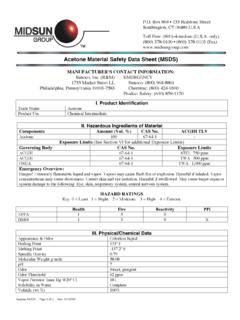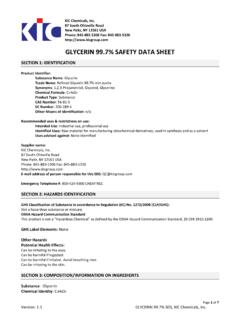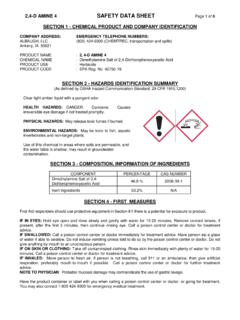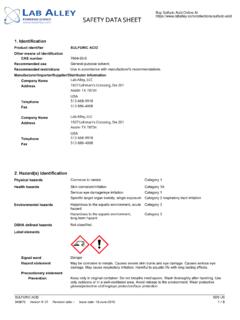Transcription of ANSI / ISEA Z358.1-2014 Compliance Checklist
1 ANSI / ISEA Compliance Checklist2 Guardian Equipment1140 N North Branch StChicago, IL 60642312 447 8100 telephone312 447 8101 / ISEA Compliance ChecklistListed 8116. Units have been tested to and comply with ANSI and the Uniform Plumbing selection of emergency eyewash and shower equipment is often a complicated process. In addition to addressing design and engineering issues, specifiers must be aware of regulatory requirements and Compliance standards. A common reference point when selecting emergency equipment is ANSI/ISEA , Emergency Eyewash and shower Equipment. This standard is a widely accepted guideline for the proper selection, installation, operation and maintenance of emergency assist specifiers in understanding the provisions of this standard, Guardian Equipment has prepared this ANSI Compliance Checklist . In this Checklist , we have summarized and graphically presented the provisions of the standard.
2 This Checklist can serve as a starting point for designing emergency eyewash and shower REQUIREMENTSThe Occupational Safety and Health Act of 1970 was enacted to assure that workers are provided with safe and healthful working conditions. Under this law, the Occupational Safety and Heath Administration (OSHA) was created and authorized to adopt safety standards and regulations to fulfill the mandate of improving worker has adopted several regulations that refer to the use of emergency eyewash and shower equipment. The primary regulation is contained in 29 CFR , which requires ..where the eyes or body of any person may be exposed to injurious corrosive materials, suitable facilities for quick drenching or flushing of the eyes and body shall be provided within the work area for immediate emergency use. ANSI OSHA regulation regarding emergency equipment is quite vague, in that it does not define what constitutes suitable facilities for drenching the eyes or body.
3 In order to provide additional guidance to employers, the American National Standards Institute (ANSI) has established a standard covering emergency eyewash and shower equipment. This standard ANSI is intended to serve as a guideline for the proper design, certification, performance, installation, use and maintenance of emergency equipment. As the most comprehensive guide to emergency showers and eyewashes, it has been adopted by many governmental health and safety organizations within and outside the US, as well as the Uniform Plumbing Code (UPC) and International Plumbing Code (IPC). The ANSI standard is part of the building code in locations that have adopted the International Plumbing Code. (IPC-Sec. 411)ANSI was originally adopted in 1981. It was revised in 1990, 1998, 2004, 2009 and again in 2014. This Compliance Checklist summarizes and graphically presents the provisions of the 2014 version of the Guardian Equipment1140 N North Branch StChicago, IL 60642312 447 8100 telephone312 447 8101 / ISEA Compliance ChecklistListed 8116.
4 Units have been tested to and comply with ANSI and the Uniform Plumbing eyewash and shower units are designed to deliver water to rinse contaminants from a user s eyes, face or body. As such, they are a form of first aid equipment to be used in the event of an accident. However, they are not a substitute for primary protective devices (including eye and face protection and protective clothing) or for safe procedures for handling hazardous LOCATION OF EMERGENCY EQUIPMENTIn general, the ANSI standard provides that emergency equipment be installed within 10 seconds walking time from the location of a hazard (approximately 55 feet) (Appendix B5). The equipment must be installed on the same level as the hazard ( accessing the equipment should not require going up or down stairs or ramps). The path of travel from the hazard to the equipment should be free of obstructions and as straight as , there are certain circumstances where these guidelines may not be adequate.
5 Previous versions of the standard expressly provided that, where workers are handling particularly strong acids, caustics or other materials where the consequences of a spill would be very serious, emergency equipment should be installed immediately adjacent to the hazard. Although Appendix B5 of the 2014 standard briefly reviews the proper location of emergency equipment under such scenarios, we still believe the previous versions of the standard to be environments may also require special consideration. It has been common in many laboratory buildings to install emergency equipment in a corridor or hallway outside of the lab room. Since a door is considered an obstruction, this violates the provisions of the standard. For laboratory environments, we recommend installing (i) recessed laboratory eyewash/ shower cabinets inside the lab room and (ii) dual purpose eyewash/drench hose units at lab sinks (see page 8). The recessed cabinet units are a space saving design that satisfy the standard s requirements for both a shower and an eye/face wash , and are wheelchair accessible, while the eyewash/drench hoses provide immediate protection for the eyes, face or body when a spill involves a relatively small amount of hazardous WATER TEMPERATUREThe 2014 version of the standard states that the water temperature delivered by emergency equipment should be tepid.
6 Tepid is defined to be between 60 F (16 C) and 100 F (38 C). However, in circumstances where a chemical reaction is accelerated by flushing fluid temperature, a facilities safety/health advisor should be consulted to determine the optimum water temperature for each delivery of tepid water to emergency equipment may raise complicated engineering issues. At a minimum, it generally involves providing both hot and cold water to the unit, and then installing a mixing valve to blend the water to the desired temperature. Guardian offers a variety of mixing valves and turnkey, recirculating tempering systems to provide tempered water. Please contact our office for further SHUT OFF VALVESP lumbed emergency equipment must be connected to a potable water supply line. It may be advisable to install a shut off valve on the water line, upstream of the unit, to facilitate maintenance of the equipment. If a shut off valve is installed, provision must be made to prevent unauthorized closure of the shut off valve.
7 (Sections , , , , , , ) Such provision can include removing the handle of the shut off valve or locking the valve in the open position. Only maintenance personnel should be authorized to place a handle on or unlock the CORROSION RESISTANCEOnce connected to a water supply line, water will enter the emergency equipment and stand in the unit up to the valve(s). When activated, water will flow through the entire unit. Therefore, the unit must be constructed of materials that will not corrode when exposed to water for extended periods of time. (Sections , , ) In addition to this general provision, the standard specifically requires that valves be resistant to corrosion. (Sections , , , ) Emergency equipment should therefore be constructed of materials that will resist rusting and corrosion. Materials that are considered GENERAL CONSIDERATIONSANSI 2014 contains provisions regarding the design, certification, performance, installation, use and maintenance of various types of emergency equipment (showers, eyewashes, drench hoses, etc.)
8 In addition to the provisions in the standard, there are additional considerations that are not part of the standard. We believe that these considerations should also be addressed when considering emergency equipment. These include the following:1. FIRST AID DEVICES4 Guardian Equipment1140 N North Branch StChicago, IL 60642312 447 8100 telephone312 447 8101 / ISEA Compliance ChecklistListed 8116. Units have been tested to and comply with ANSI and the Uniform Plumbing for this purpose include brass, galvanized steel and many types of plastics (ABS, nylon, etc.). However, these materials may not provide durable service when exposed to harsh industrial conditions, may deteriorate in direct sunlight or be subject to other limitations. Therefore, for maximum durability, the following materials should also be considered: Epoxy coated galvanized steel Epoxy coated brass Stainless steel PVC6. FREEZINGT here are many applications where emergency equipment must be installed in areas that are subject to freezing conditions.
9 Such areas may include any type of outdoor area (bulk material handling facility, tank farm, etc.), as well as some interior areas (loading docks, low temperature facilities, etc.). In these cases, the emergency equipment must be protected against freezing (Sections , , , , ). Equipment that is designed and manufactured to be freeze-resistant should be installed. There are a number of different types of freeze-resistant equipment, including: Units that have a temperature actuated bleed valve that permits water to flow through the unit when the temperature drops below freezing. These units are generally used only where the possibility of freezing is very infrequent. Units on which the valve is mounted behind a wall or buried below the frost line and is remote-activated. Combination units that are electrically heated (heat-traced) and insulated. Units that have a heated enclosure to fully contain and protect both the equipment and the DISPOSAL OF WATERThe standard does not include any specific provisions regarding the disposal of waste water (Appendix A3).
10 However, designers must give consideration to where waste water will go. In particular, care must be taken that waste water not create a hazard ( by creating a pool in which someone might slip) or , Guardian eyewash, eye/face wash and safety station units are designed with waste connections for connection to drain piping. WE RECOMMEND THAT EMERGENCY EYEWASH AND shower UNITS BE CONNECTED TO DRAIN PIPING. FOR EMERGENCY SHOWERS AND FOR OTHER UNITS WITHOUT WASTE CONNECTIONS, FLOOR DRAINS SHOULD BE PROVIDED. After an emergency eyewash or shower unit has been used, the waste water may contain hazardous materials that cannot or should not be introduced into a sanitary sewer. It may be necessary to connect the drain piping from the emergency equipment or floor drain to the building s acid waste disposal system or to a neutralizing EMERGENCY RESPONSES imply installing emergency equipment is not sufficient to assure worker safety.
